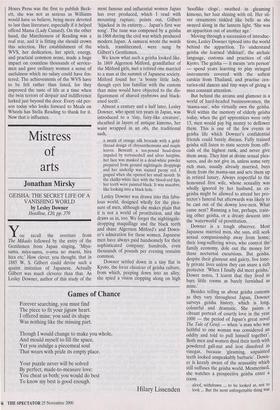Mistress of arts
Jonathan Mirsky
GEISHA: THE SECRET LIFE OF A VANISHING WORLD by Lesley Downer Headline, £20, pp. 370 You recall the overture from The Mikado followed by the entry of the Gentlemen from Japan singing, `Miya- sama, miya-sama, o-uma no maeni, hira hira etc.' How clever, you thought, that in 1885 W. S. Gilbert could devise such a quaint imitation of Japanese. Actually Gilbert was much cleverer than that. As Lesley Downer, author of this study of the most famous and influential women Japan has ever produced, which I read with mounting rapture, points out, Gilbert `hijacked in its entirety... Japan's first war song'. The tune was composed by a geisha in 1868 during the civil war which produced modern Japan. A samurai wrote the words which, transliterated, were sung by Gilbert's Gentlemen.
We know what such a geisha looked like. In 1869 Algernon Mitford, grandfather of the Mitford girls, met a retired one married to a man at the summit of Japanese society. Mitford found her 'a bonny little lady, though eyes less familiar with the custom than mine would have objected to the dis- figurement of shaved eyebrows and black- ened teeth'.
Almost a century and a half later, Lesley Downer, who spent ten years in Japan, was introduced to a 'tiny, fairy-like creature', sheathed in layers of antique kimono, her waist wrapped in an obi, the traditional sash, a swath of orange silk brocade with a gold- thread design of chrysanthemums and maple leaves. Beneath a ten-pound head-dress impaled by tortoiseshell and silver hairpins, her face was masked in a dead-white powder prepared from ground nightingale droppings and her underlip was stained peony red. I gasped when she opened her small mouth. In the chalky-white face with the blood-red lips, her teeth were painted black. It was macabre, like looking into a black hole.
Lesley Downer was drawn into this fabu- lous world, designed wholly for the plea- sure of men, although she makes plain that it is not a world of prostitution, and she draws us in, too. We forget the nightingale- dropping maquillage and the black teeth and share Algernon Mitford's and Down- er's admiration for these women. Japanese men have always paid handsomely for their sophisticated company; hundreds, even thousands of pounds per evening remains common.
Downer settled down in a tiny flat in Kyoto, the locus classicus of geisha culture, from which, peeping down into an alley, she spied a vision clopping along on high `hooflike clogs', swathed in gleaming kimono, her hair shining with oil. Her sil- ver ornaments tinkled like bells as she swayed along in the lantern light. 'She was an apparition out of another age.'
Moving through a succession of introduc- tions, Lesley Downer tiptoed into the world behind the apparition. To understand geisha she learned `shikitari', the archaic language, customs and practices of old Kyoto. The geisha — it means 'arts person' — spend years learning to play stringed instruments covered with the softest catskin from Thailand, and practise cen- turies-old dances and tiny ways of giving a man constant attention.
But behind the arcana and glamour is a world of hard-headed businesswomen, the `mama-san', who virtually own the geisha. Well within the memory of elderly geisha today, when the girl apprentices were only 13, men would pay big money to deflower them. This is one of the few events in geisha life which Downer's confidential friends could barely discuss. Fully trained geisha still listen to state secrets from offi- cials of the highest rank, and never give them away. They hint at divine sexual plea- sures, and do not give in, unless some very rich man, usually already married, buys them from the mama-san and sets them up in retired luxury. Always respectful to the honoured first wife, whose sexuality was wholly ignored by her husband, an ex- geisha might be allowed to attend her pro- tector's funeral but afterwards was likely to be cast out of the downy love-nest. What came next? Running a bar, perhaps, train- ing other geisha, or a dreary descent into the `waterworld' of prostitution.
Downer is a tough observer. Most Japanese married men, she says, still seek sexual companionship away from home; their long-suffering wives, who control the family economy, dole out the money for these nocturnal excursions. But geisha, despite their glamour and gaiety, live lone- ly private lives unless they can snare a rich protector. 'When I finally did meet geisha,' Dower notes, 'I learnt that they lived in bare little rooms as barely furnished as mine.'
Besides telling us about geisha customs as they vary throughout Japan, Downer surveys geisha history, which is long, colourful and dramatic. She paints a vibrant portrait of courtly love in the year 1000 — the period of Japan's great novel The Tale of Genii — when 'a man who was faithful to one woman was considered an oddity and told to pull himself together'. Both men and women dyed their teeth with powdered gall-nut and iron dissolved in vinegar, because 'gleaming, unpainted teeth looked unspeakably barbaric'. Down- er is keenly aware of the sensuality which still suffuses the geisha world. Mesmerised, she watches a prospective geisha enter a room
aloof, withdrawn ... to be looked at, not to look ... But the most unforgettable thing was that under the layers and layers of brocade and silk, her tiny feet were bare, It was the most erotic sight, it sent a shiver up the spine.'
Lesley Downer has created a master- piece in subject and mood; her style suits the restrained elegance, what geisha call `shibui', of her subject. She knows that the geisha live, off-duty, in shabby flats. But she sees them, too, as `shamanesses who could transport men into another world, a world of dreams'.






























































































 Previous page
Previous page